
The three University of Illinois round barns played a special role in the promotion and popularity of the American round barn. They are located in Urbana Township, on the border of the U.S. city of Urbana, Illinois and on the campus of the University of Illinois Urbana-Champaign. The University of Illinois was home to one of the Agricultural Experiment Stations, located at U.S. universities, which were at the heart of the promotion of the round barn. At least one round barn in Illinois was built specifically after its owner viewed the barns at the university. Though originally an experiment the three barns helped to lead the way for round barn construction throughout the Midwest, particularly in Illinois. The barns were listed as contributing properties to the U of I Experimental Dairy Farm Historic District, which was listed on the U.S. National Register of Historic Places in 1994.

The Hoard's Dairyman Farm, just north of Fort Atkinson, Wisconsin, was purchased in 1899 by W. D. Hoard, a former governor of Wisconsin. Hoard used the farm as a laboratory for testing ideas for his magazine Hoard's Dairyman, like the use of alfalfa for feeding dairy cattle.

The Fred B. Jones House is part of an estate called Penwern in Delavan, Wisconsin, designed by Frank Lloyd Wright and constructed from 1900 to 1903. It was listed on the National Register of Historic Places in 1974.
The Spotts Round Barn is a historic building located near Charles City in rural Floyd County, Iowa, United States. It was built in 1914 as a dairy and horse barn. Its design was influenced by the Iowa Agricultural Experiment Station. The building is a true round barn that measures 55 feet (17 m) in diameter. It is constructed of clay tile from the Johnston Brothers Clay Works. It features a two-pitch roof, a large hay dormer on the north side and a 12-foot (3.7 m) central silo. The barn has been listed on the National Register of Historic Places since 1986.
The Waveland Round Barn was a historic building located near Cushing in rural Ida County, Iowa, United States. Built in 1900, the barn measured 50 feet (15 m) in diameter. It featured red vertical siding, a large central section with a conical roof, a wing section that surrounded the central section with a sectional roof and a hay dormer above the main entrance on the east side. The three-story central section makes this an unusual round barn in Iowa. It was listed on the National Register of Historic Places in 1986. The barn was bulldozed and the remains were burnt in March 2012.
The George Darrow Round Barn is a historic building located near Alta Vista in rural Chickasaw County, Iowa, United States. The true round barn was constructed of clay tile in 1916. The use of clay tiles suggests that it was influenced by the work of the Iowa Agricultural Experiment Station in the early 20th-century. It has a diameter 64 feet (20 m), and a height of 50 feet (15 m). The barn features a two-pitch roof and a 14-foot (4.3 m) central clay tile silo. It was built as a dairy barn and it was used as such until 1978. Dairy cow stanchions surround the central silo on one side of the barn in a circular arrangement, and horse stalls surround the other side. The barn has been listed on the National Register of Historic Places (NRHP) since 1986. It has subsequently been torn down. It was removed from the NRHP in 2022.
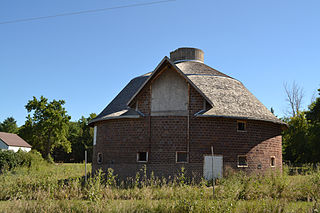
The Slayton Farms-Round Barn is a historic building located near Iowa Falls in rural Hardin County, Iowa, United States. Frank Slayton had it built in 1915 for use as a dairy barn. The barn is one of 16 that was built by the Johnston Brothers Clay Works from Fort Dodge, Iowa. It is constructed of hollow clay tiles and features a gambrel roof with two different pitches and hay dormer. Two aerators flank the central silo on the roof. The interior of the barn is fashioned around the silo from which silage was shoveled to feed the cattle. An overhead track system and a bucket for hauling materials remains intact. It has been listed on the National Register of Historic Places since 1999. Purchased by Engel Family in 2023.
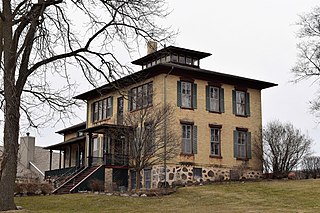
The Ferdinand C. Hartwig House is a historic house located at 908 Country Lane in Watertown, Wisconsin. It was added to the National Register of Historic Places on June 17, 1982.
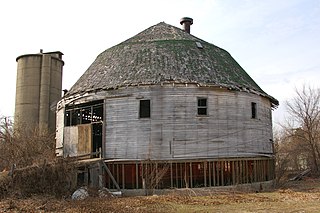
The Dougan Round Barn in Beloit, Wisconsin, United States, was a round barn that was built in 1911. It was listed on the National Register of Historic Places in 1979. It was demolished in 2012.

The Corson Emminger Round Barn near Watertown, South Dakota, United States, is a round barn that was built during 1909–1910 by Corson Emminger. It was listed on the National Register of Historic Places in 1978.
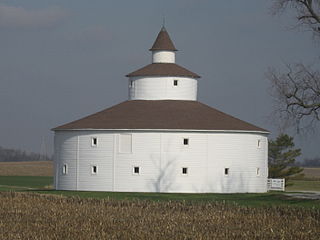
The Strauther Pleak Round Barn, also known as the "Pleak-Morgan Barn", is a round barn near Greensburg, Indiana, United States in Washington Township. Built in 1914, it was listed on the National Register of Historic Places in 1993. The barn is part of farmstead with a circa 1940 Indiana limestone ranch house, smoke house, spring house and garage. The main drive is looped enclosing a pen with a chicken coop and smaller barn.
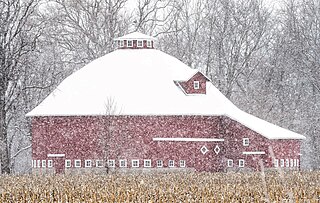
The John Haimbaugh Round Barn in Newcastle Township near Rochester, Indiana, United States, is a round barn that was built in 1914. It was listed on the National Register of Historic Places in 1993.

The Louden Machinery Company was an American engineering, manufacturing and design company based in Fairfield, Iowa. Founded by William Louden, the company in its early years manufactured and sold the patented hay carrier that he invented in 1867. The company later expanded into a wide variety of farm equipment and, in 1906, began an Architecture Department that reportedly designed more than 25,000 barns from 1906 to 1939. During World War I, Louden's monorail equipment carrier began to be applied to industrial and military applications. By the 1920s, much of the company's revenues were derived from industrial applications of its monorail equipment carriers.

The Flynn Farm, Mansion, and Barn, also known as the Flynn Farm, Walnut Hill Farm, Clive Honor Farm, comprise a historic district located near Des Moines, Iowa, United States. It was listed on the National Register of Historic Places in 1973.

The Menno Yoder barn is one of the two remaining poured concrete polygonal barns in the United States state of Indiana. Built on the outskirts of Shipshewana in 1908 by Menno Yoder, this twelve-sided barn has been expanded upon. It is known as the Brown Swiss Dairy barn. A gravel drive extends to the barn, passing the 1911 concrete farmhouse. The polygonal barn consists of the original 1908 twelve-sided barn, a 1911 attached silo, a c.1920 rectangular addition, and a 1960s one story addition. Next to the barn is a free standing c.1950 milk house.
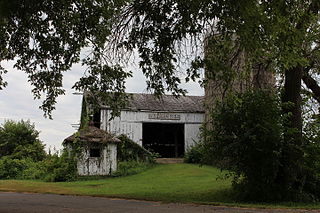
The Erastus Dean Farmstead in Bradford, Wisconsin is probably the oldest complex of farm buildings in Rock County, with the house built in 1840 and the barn in 1844. The farm was listed on the National Register of Historic Places in 1978 and on the State Register of Historic Places in 1989.

The John Sweet Donald Farmstead is a historic farm in Springdale, Wisconsin with surviving structures built as early as 1858. It is significant as the home and testing grounds of John Sweet Donald, a farmer, statesman, and educator of the Progressive Era.

The Adam Dunlap Farmstead, built by a Yankee settler family, was one of the first farms in the Town of Mazomanie, Wisconsin. A number of the original structures, built around 1849 from stone quarried on the farm, are still intact. The farmstead was added to the State and the National Register of Historic Places in 2003, for being a relatively intact homestead of a progressive Yankee pioneer settler, and for the Greek Revival style of the stone farmhouse.
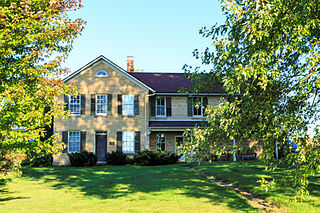
The John Fritz Farmstead is located in Montrose, Wisconsin. It was added to the National Register of Historic Places, along with the State Register of Historic Places, in 1998.
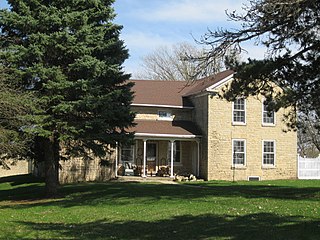
The Samuel Hall House is a Greek Revival-styled farmhouse built in 1856 in Albion, Dane County, Wisconsin. It was added to the State and the National Register of Historic Places in 1993.




















